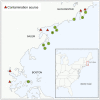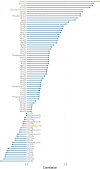Evidence of elevated heavy metals concentrations in wild and farmed sugar kelp (Saccharina latissima) in New England
- PMID: 37848595
- PMCID: PMC10582040
- DOI: 10.1038/s41598-023-44685-4
Evidence of elevated heavy metals concentrations in wild and farmed sugar kelp (Saccharina latissima) in New England
Abstract
Seaweed farming in the United States is gaining significant financial and political support due to prospects to sustainably expand domestic economies with environmentally friendly products. Several networks are seeking appropriate synthesis of available science to both inform policy and substantiate the sector's sustainability claims. Significant knowledge gaps remain regarding seaweed-specific food hazards and their mitigation; a resource-intensive challenge that can inhibit sustainable policies. This is particularly concerning for rapidly expanding Saccharina latissima (sugar kelp) crops, a brown seaweed that is known to accumulate heavy metals linked to food hazards. Here, we present baseline information about concentrations of arsenic, cadmium, lead, and mercury, in both wild and farmed sugar kelp from the New England region. We interpret our findings based on proximity to potential sources of contamination, location on blade, and available heavy metals standards. Contrary to our expectations, high concentrations were widespread in both wild and farmed populations, regardless of proximity to contamination. We find, like others, that cadmium and arsenic consistently reach levels of regulatory concern, and that dried seaweeds could harbor higher concentrations compared to raw products. We also share unique findings that suggest some toxins concentrate at the base of kelp blades. Our results are one step towards aggregating vital data for the region to expand its seaweed farming footprint.
© 2023. Springer Nature Limited.
Conflict of interest statement
The authors declare no competing interests.
Figures






Similar articles
-
Skinny kelp (Saccharina angustissima) provides valuable genetics for the biomass improvement of farmed sugar kelp (Saccharina latissima).J Appl Phycol. 2022;34(5):2551-2563. doi: 10.1007/s10811-022-02811-1. Epub 2022 Aug 20. J Appl Phycol. 2022. PMID: 36033835 Free PMC article.
-
Environmental impact of kelp (Saccharina latissima) aquaculture.Mar Pollut Bull. 2020 Jun;155:110962. doi: 10.1016/j.marpolbul.2020.110962. Epub 2020 May 18. Mar Pollut Bull. 2020. PMID: 32469791
-
Quality and safety aspects in fermentation of winged kelp (Alaria esculenta) and sugar kelp (Saccharina latissima) by the natural microbiota with or without addition of a Lactiplantibacillus plantarum starter culture.Food Res Int. 2021 Dec;150(Pt B):110800. doi: 10.1016/j.foodres.2021.110800. Epub 2021 Nov 8. Food Res Int. 2021. PMID: 34863492
-
The sugar kelp Saccharina latissima I: recent advances in a changing climate.Ann Bot. 2024 Mar 8;133(1):183-212. doi: 10.1093/aob/mcad173. Ann Bot. 2024. PMID: 38109285 Free PMC article. Review.
-
Hazards of heavy metal contamination.Br Med Bull. 2003;68:167-82. doi: 10.1093/bmb/ldg032. Br Med Bull. 2003. PMID: 14757716 Review.
References
-
- Barberi ON, Byron CJ, Burkholder KM, St Gelais AT, Williams AK. Assessment of bacterial pathogens on edible macroalgae in coastal waters. J. Appl. Phycol. 2020;32(1):683–696. doi: 10.1007/s10811-019-01993-5. - DOI
-
- Yarish, C., Kim, J. K., Lindell, S. & Kite-Powell, H. Developing an environmentally and economically sustainable sugar kelp aquaculture industry in southern New England: From seed to market. https://opencommons.uconn.edu/eeb_articles/38 (2017).
-
- Bricknell IR, et al. Resilience of cold water aquaculture: A review of likely scenarios as climate changes in the Gulf of Maine. Rev. Aquac. 2021;13(1):460–503. doi: 10.1111/raq.12483. - DOI
-
- Troell M, Henriksson PJ, Buschmann AH, Chopin T, Quahe S. Farming the ocean–seaweeds as a quick fix for the climate? Rev. Fish. Sci. Aquac. 2022 doi: 10.1080/23308249.2022.2048792. - DOI
-
- Theuerkauf SJ, et al. Habitat value of bivalve shellfish and seaweed aquaculture for fish and invertebrates: Pathways, synthesis and next steps. Rev. Aquac. 2022;14(1):54–72. doi: 10.1371/journal.pone.0222282. - DOI
Publication types
MeSH terms
Substances
Supplementary concepts
Grants and funding
LinkOut - more resources
Full Text Sources
Medical

